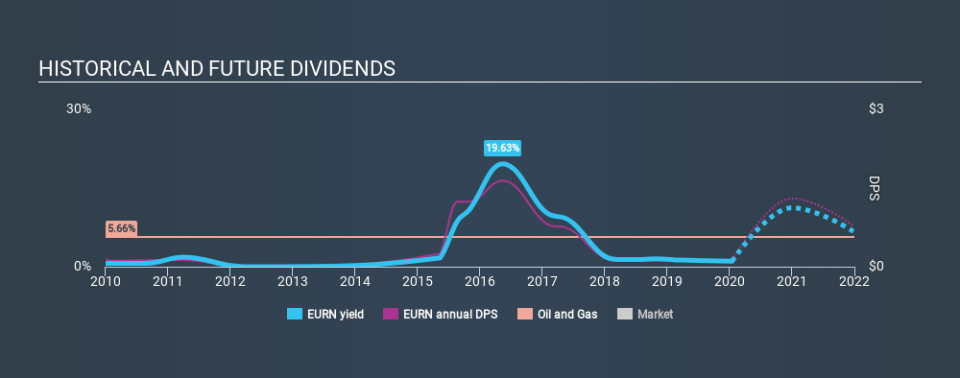Something To Consider Before Buying Euronav NV (EBR:EURN) For The 1.0% Dividend

Today we'll take a closer look at Euronav NV (EBR:EURN) from a dividend investor's perspective. Owning a strong business and reinvesting the dividends is widely seen as an attractive way of growing your wealth. Yet sometimes, investors buy a stock for its dividend and lose money because the share price falls by more than they earned in dividend payments.
A 1.0% yield is nothing to get excited about, but investors probably think the long payment history suggests Euronav has some staying power. The company also bought back stock equivalent to around 1.3% of market capitalisation this year. Some simple research can reduce the risk of buying Euronav for its dividend - read on to learn more.
Click the interactive chart for our full dividend analysis
Payout ratios
Dividends are usually paid out of company earnings. If a company is paying more than it earns, then the dividend might become unsustainable - hardly an ideal situation. As a result, we should always investigate whether a company can afford its dividend, measured as a percentage of a company's net income after tax. Although it reported a loss over the past 12 months, Euronav currently pays a dividend. When a company is loss-making, we next need to check to see if its cash flows can support the dividend.
Of the free cash flow it generated last year, Euronav paid out 33% as dividends, suggesting the dividend is affordable.
Is Euronav's Balance Sheet Risky?
Given Euronav is paying a dividend but reported a loss over the past year, we need to check its balance sheet for signs of financial distress. A quick check of its financial situation can be done with two ratios: net debt divided by EBITDA (earnings before interest, tax, depreciation and amortisation), and net interest cover. Net debt to EBITDA is a measure of a company's total debt. Net interest cover measures the ability to meet interest payments. Essentially we check that a) the company does not have too much debt, and b) that it can afford to pay the interest. Euronav has net debt of 4.00 times its EBITDA, which is getting towards the limit of most investors' comfort zones. Judicious use of debt can enhance shareholder returns, but also adds to the risk if something goes awry.
We calculated its interest cover by measuring its earnings before interest and tax (EBIT), and dividing this by the company's net interest expense. Euronav has interest cover of less than 1 - which suggests its earnings are not high enough to cover even the interest payments on its debt. This is potentially quite serious, and we would likely avoid the stock if it were not resolved quickly.
Consider getting our latest analysis on Euronav's financial position here.
Dividend Volatility
From the perspective of an income investor who wants to earn dividends for many years, there is not much point buying a stock if its dividend is regularly cut or is not reliable. Euronav has been paying dividends for a long time, but for the purpose of this analysis, we only examine the past 10 years of payments. The dividend has been cut on at least one occasion historically. During the past ten-year period, the first annual payment was US$0.14 in 2010, compared to US$0.12 last year. The dividend has shrunk at around 1.8% a year during that period. Euronav's dividend hasn't shrunk linearly at 1.8% per annum, but the CAGR is a useful estimate of the historical rate of change.
We struggle to make a case for buying Euronav for its dividend, given that payments have shrunk over the past ten years.
Dividend Growth Potential
With a relatively unstable dividend, it's even more important to evaluate if earnings per share (EPS) are growing - it's not worth taking the risk on a dividend getting cut, unless you might be rewarded with larger dividends in future. Euronav's earnings per share have shrunk at 35% a year over the past five years. With this kind of significant decline, we always wonder what has changed in the business. Dividends are about stability, and Euronav's earnings per share, which support the dividend, have been anything but stable.
Conclusion
When we look at a dividend stock, we need to form a judgement on whether the dividend will grow, if the company is able to maintain it in a wide range of economic circumstances, and if the dividend payout is sustainable. We're not keen on the fact that Euronav paid dividends despite reporting a loss over the past year, although fortunately its dividend was covered by cash flow. Earnings per share are down, and Euronav's dividend has been cut at least once in the past, which is disappointing. With this information in mind, we think Euronav may not be an ideal dividend stock.
Given that earnings are not growing, the dividend does not look nearly so attractive. Businesses can change though, and we think it would make sense to see what analysts are forecasting for the company.
Looking for more high-yielding dividend ideas? Try our curated list of dividend stocks with a yield above 3%.
If you spot an error that warrants correction, please contact the editor at editorial-team@simplywallst.com. This article by Simply Wall St is general in nature. It does not constitute a recommendation to buy or sell any stock, and does not take account of your objectives, or your financial situation. Simply Wall St has no position in the stocks mentioned.
We aim to bring you long-term focused research analysis driven by fundamental data. Note that our analysis may not factor in the latest price-sensitive company announcements or qualitative material. Thank you for reading.

 Yahoo Finance
Yahoo Finance 
